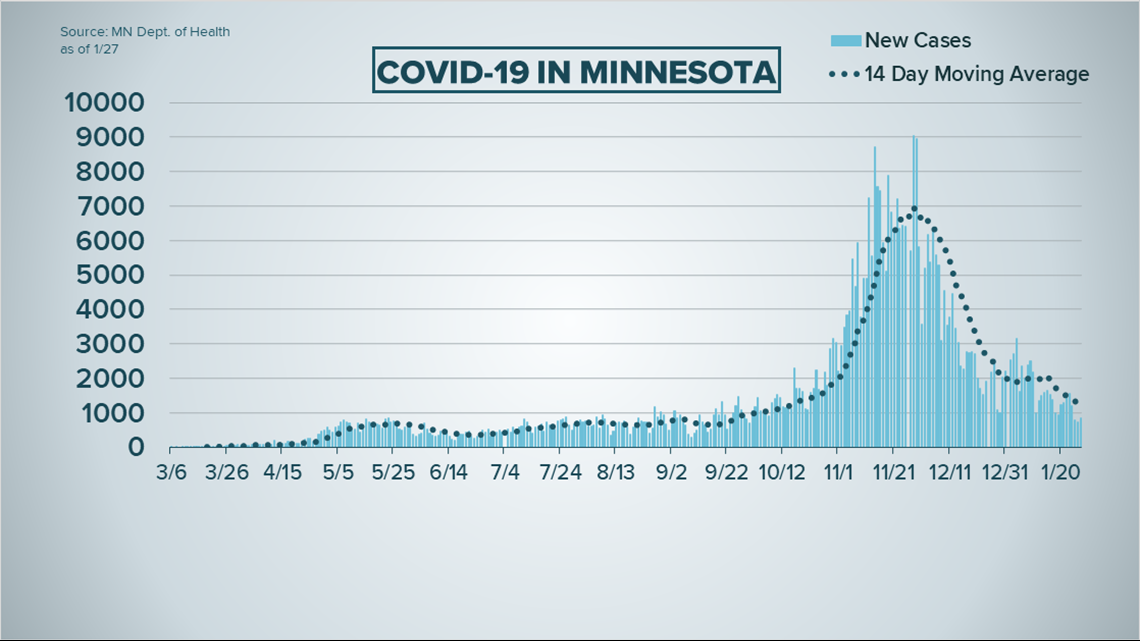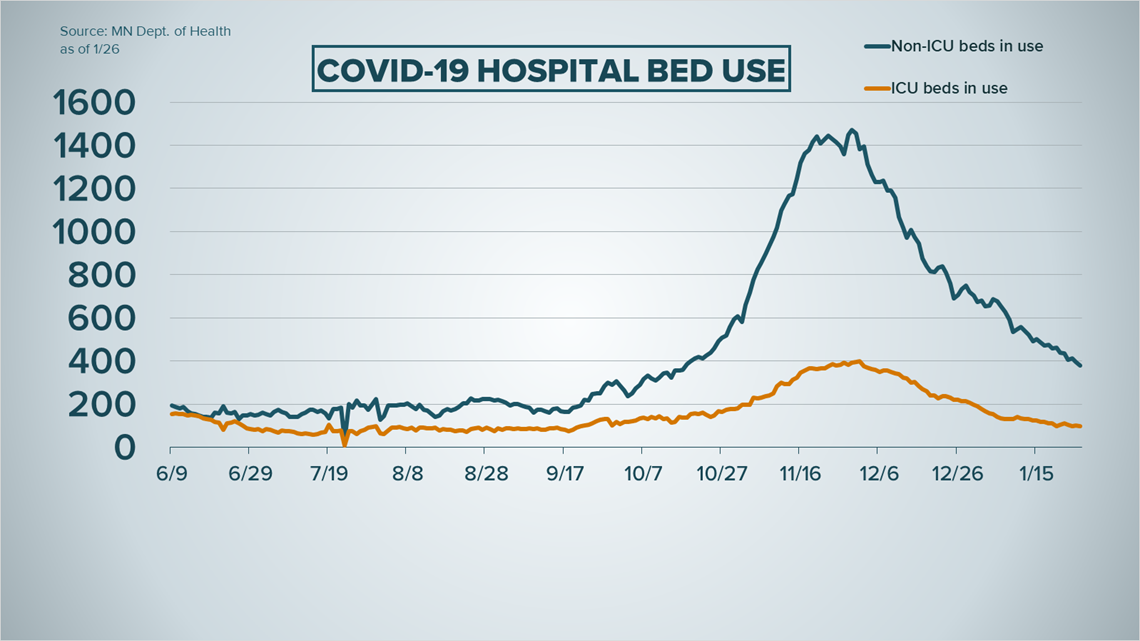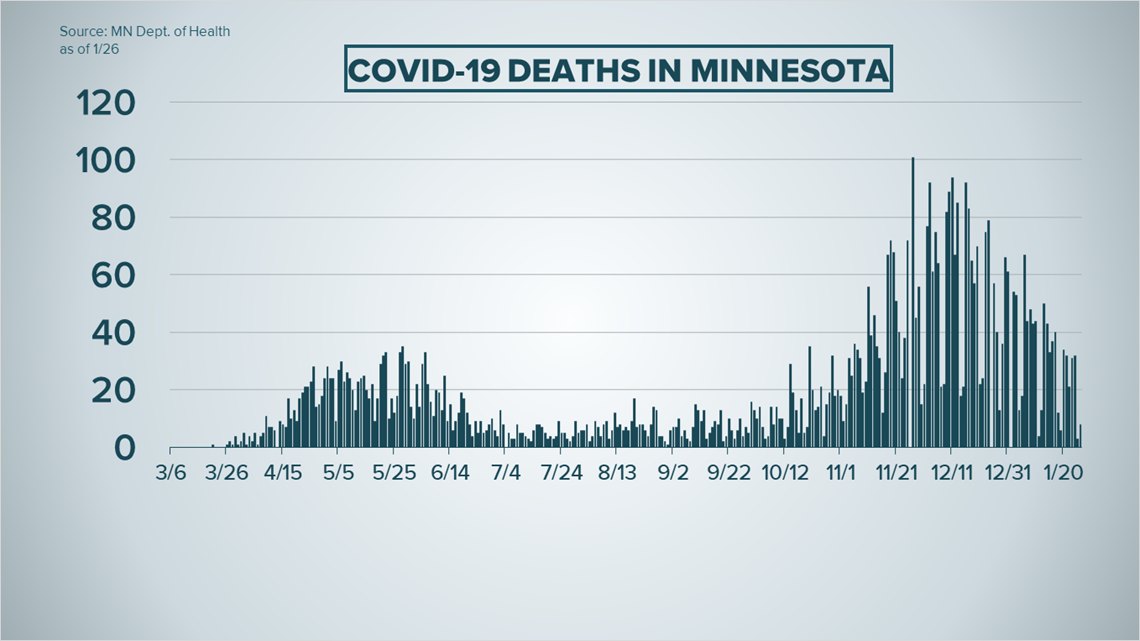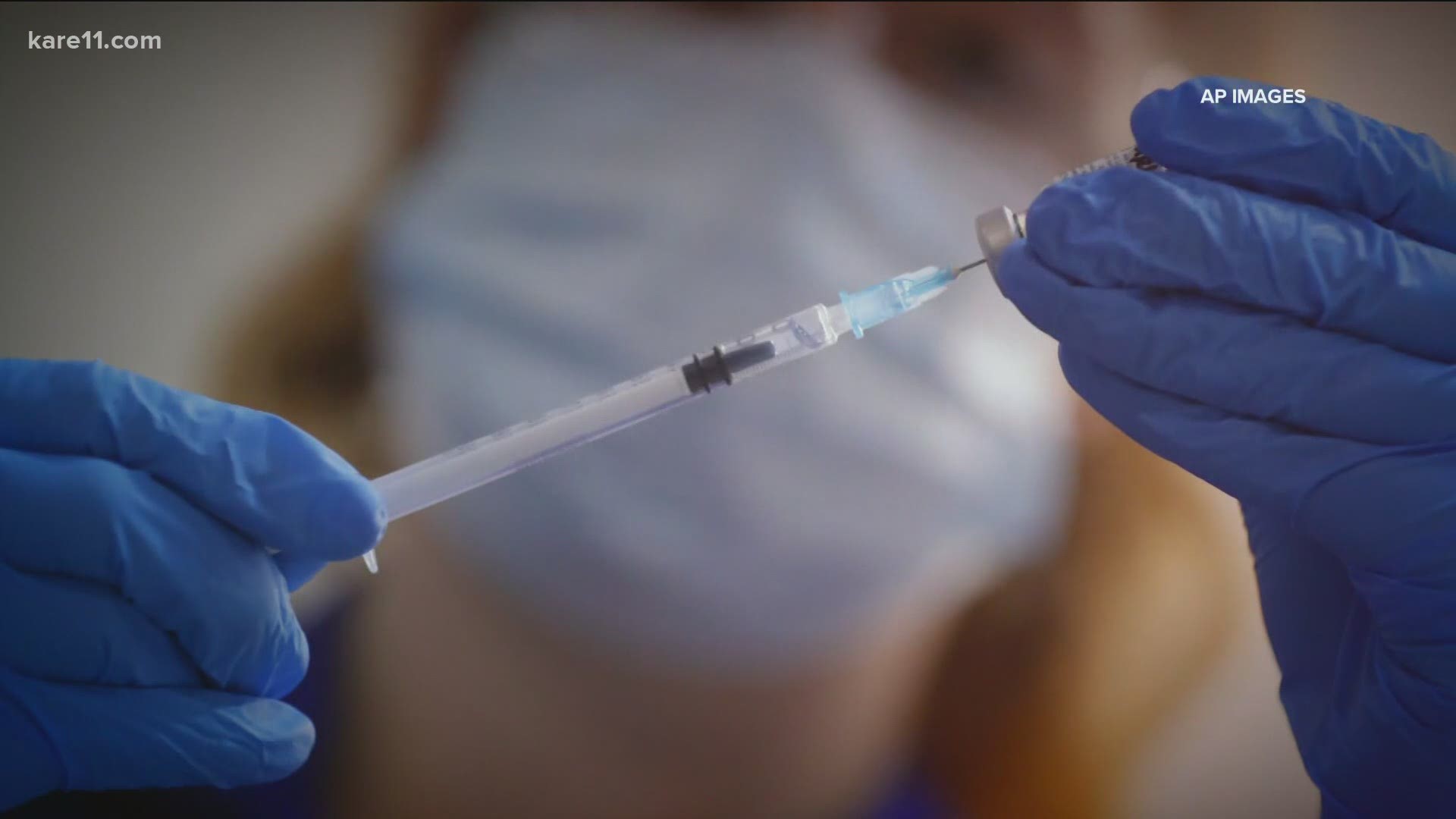Wednesday, Jan. 27
- MDH reports 18 COVID deaths, 851 new cases, slight uptick from early week numbers
- State begins notifying people randomly selected to receive vaccine
- More than 300,000 Minnesotans now have at least one COVID-19 vaccine dose
- Minnesota tiger at The Wildcat Sanctuary diagnosed with COVID-19
- First known case of Brazil COVID-19 variant in U.S. discovered in Minnesota
Both deaths from COVID-19 and new cases of the virus show a slight uptick, according to data released Wednesday by the Minnesota Department of Health (MDH).
State health officials say 18 lives were reported lost in the last day, after two consecutive days of single-digit deaths. Total coronavirus fatalities in Minnesota since the pandemic began now sit at 6,124. Of those deaths 3,887, or 63% of them are tied to long-term care or assisted living settings.
MDH says 851 new COVID cases were recorded, based on 20,899 tests (15,620 PCR, 5,279 antigen) processed in private and state labs. Health experts consider a positive PCR test a confirmed COVID case, while a positive antigen test is considered a probable case.
Testing volume was nearly double Tuesday's totals.


Minnesota's total positive cases have reached 457,317, with 19,375 of those based on antigen tests.
The state vaccination effort has passed another milestone with more than 300,000 Minnesotans having received at least one vaccine dose (301,290). The vaccine dashboard says 73,304 people have completed the two-shot series. MDH says health providers have administered 95% of the vaccine they've received within seven days time. That does not include second doses that cannot be administered due to a patient's mandatory wait time.
MDH data shows the number of hospital beds being used to treat COVID patients continues to drop slowly, with 477 being used statewide as of Tuesday (97 beds in ICU). Bed availability is holding steady at hospitals in the Twin Cities metro, with just 3.5% of non-ICU beds available, and ICU bed availability at 8.7%.
Total hospitalizations have climbed to 24,073, with ICU patients now exceeding the 5,000 mark (5,004).


Of those Minnesotans who have been diagnosed with COVID at one time, 441,740 have recovered to the point they no longer require isolation.
The largest COVID-19 case grouping involves young adults ages 20 to 24, with 46,071 cases and three deaths, followed by those 25 to 29 with 41,116 cases ad six deaths. People between 85 and 89 make up the largest group of fatalities with 1,167 deaths in 5,996 diagnosed cases.
Hennepin County has recorded the most COVID activity in the state with 94,872 cases and 1,509 deaths, followed by Ramsey County with 40,815 cases and 753 deaths, Dakota County with 33,748 cases and 357 deaths, and Anoka County with 31,494 cases and 369 fatalities.
Cook County in northeastern Minnesota remains quiet on the COVID front, with just 116 diagnosed cases and zero deaths.
Tuesday, Jan. 26
2 p.m.
State health officials said the first discovery of a Brazilian variant of COVID-19 in Minnesota points to the importance of coronavirus testing, as the discovery was made through the state's ongoing variant testing.
"While this variant is thought to be more transmissible than the initial strain of the virus, it is not clear if the variant causes more severe disease," said Minnesota Department of Health (MDH) State Epidemiologist Dr. Ruth Lynfield.
Dr. Lynfield said the patient became ill the first week of January and was tested on Jan. 9. The patient spoke with MDH case investigators after receiving a positive COVID test, reporting recent travel to Brazil.
In addition to the Brazilian variant, Dr. Lynfield said eight cases of a variant first discovered in the U.K. have been found in Minnesota, but she believes more cases exist in the state.
"These cases show why it is important to limit travel during a pandemic," Dr. Lynfield said. "We know some people have circumstances where they really need to travel. It's important to watch for symptoms and follow public health guidance and use careful protective measures ... and to quarantine and get tested after travel."
Lynfield said widespread testing is an important tool to track what COVID-19 is doing in Minnesota. She said having fewer infections means the virus has less opportunity to evolve. Lynfield stressed the best way to slow the spread of the variant is with "tried and true prevention" methods that health officials have promoted throughout the pandemic.
MDH Assistant Lab Director Dr. Sarah Vetter said virus variants are common with any virus, and tracking those variants helps doctors learn more about virus transmission. Vetter said scientists are watching elements of the variants that could cause the virus to be more contagious.
"Based on what we know so far, Pfizer and Moderna vaccines will still have efficacy against the variants," Dr. Vetter said, noting that both vaccines can be modified if necessary, and that it is unlikely the vaccines will become completely ineffective.
Meanwhile, Minnesota's vaccine pilot program continues to accept pre-registration for people over the age of 65 through 5 a.m. Wednesday. MNIT commissioner Tarek Tomes said 180,000 people had pre-registered for week two the COVID-19 vaccine pilot program as of 1 p.m. and are now included on the waitlist, including 11,000 registrations carried over from the first week.
Tomes noted no vaccination slots were filled on Tuesday, though some users were confused after receiving a notification that they were placed on a "waitlist." All persons pre-registered are on the waitlist for a random selection process that will begin at 7 a.m. Wednesday, two hours after pre-registration closes, and those selected for a vaccine will be contacted to make a vaccine appointment.
People on the waitlist who are not selected for a vaccine on Wednesday will remain on the waitlist for later vaccine lottery selections as well, Tomes said. The state will not delete the remaining names and will carry those names over for the future.
Tomes encourages registrants who encountered errors that their address did not qualify for the program should reapply online and ensure their address entries are correct.
"There are no addresses in Minnesota that are not eligible for this," Tomes said.
11 a.m.
As Minnesota ramps up its efforts to vaccinate front line workers, educators and residents age 65 and over against COVID-19, numbers released Tuesday by state health officials suggests that cases and deaths continue to trend in the right direction.
Data from the Minnesota Department of Health (MDH) says 727 new cases of coronavirus were recorded in the past day, the second straight day cases have been below the 800 mark. The last time the state saw cases that low was Sept. 30, when 689 cases were reported.
The new cases were based on a very low volume of 10,929 tests (9,839 PCR, 1,090 antigen) performed in private and state labs. Health officials consider a positive PCR test a confirmed COVID case, while a positive antigen test is considered a probable case.
Minnesota has now recorded a total of 456,490 coronavirus cases since the pandemic began, with 19,226 of those cases based on antigen tests.
Another eight people have lost their lives to the virus, the second consecutive day that deaths were in single digits. The state's total fatalities due to COVID-19 now sit at 6,106.


The MDH vaccine dashboard says 284,441 people have received at least one dose, while 67,567 have completed the two-dose vaccine series. The state says 92% of the vaccine supplies received by health providers were administered to patients within seven days.
Hospital bed availability continues to improve, with 496 beds across the state currently being used to treat COVID patients. Of those beds, 100 are in ICU. Availability is tightest in the Twin Cities metro, with 4.5% of non-ICU hospital beds open, and 7.8% of ICU beds available for patients.
Total hospitalizations since the pandemic arrived in Minnesota have climbed to 24,014, with 4,995 of those patients requiring ICU care.
MDH says 440,596 people who at one time tested positive for the virus have recovered to the point they no longer require isolation.
Young adults make up the largest group of COVID cases, with those ages 20 to 24 accounting for 45,998 cases and three deaths, and their 25 to 29-year-old counterparts recording 41,048 cases and six deaths. The largest grouping of fatalities involves those 85 to 89, with 1,163 deaths in just 5,991 confirmed cases.
Hennepin County has recorded the most COVID activity in the state with 94,707 cases and 1,506 deaths, followed by Ramsey County with 40,752 cases and 750 deaths, Dakota County with 33,684 cases and 355 deaths, and Anoka County with 31,437 cases and 368 fatalities.
Cook County in northeastern Minnesota has reported the least COVID activity with 116 cases and zero deaths.
KARE 11’s coverage of the coronavirus is rooted in Facts, not Fear. Visit kare11.com/coronavirus for comprehensive coverage, and kare11.com/vaccine for answers to all of your questions about the race to get the U.S. vaccinated. Have a question? Text it to us at 763-797-7215. And get the latest coronavirus updates sent right to your inbox every morning. Subscribe to the KARE 11 Sunrise newsletter here. Help local families in need: www.kare11.com/give11.
The state of Minnesota has set up a data portal online at mn.gov/covid19.

